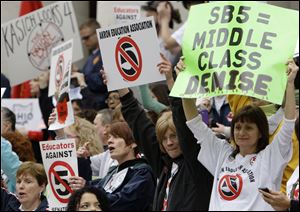
A look at Ohio's fall ballot issues
9/26/2011
Protestors against Senate Bill 5 gather at the Ohio Statehouse for a rally launching the "We Are Ohio" campaign in Columbus.
COLUMBUS-- A clash of political philosophies will play out at Ohio's ballot box this fall in questions concerning public employee unions and a federal health-insurance mandate.
Labor unions and their Democratic allies have launched a multi-million-dollar effort to repeal a bill lawmakers passed this spring limiting the collective bargaining abilities of 350,000 government workers around the state, a measure backed by Republican Gov. John Kasich as a way to contain costs.
Tea party groups, joined by Republicans, are pushing a constitutional amendment that would prohibit government from requiring Ohioans to buy health insurance, a backlash against President Barack Obama's federal health care overhaul.
The two campaigns raise sweeping themes — of class equity, the roles of government, labor unions and taxpayers, and America's partisan divide.
It is an unusually intense off-year election that also includes a third ballot question. Issue 1, endorsed by the Ohio State Bar Association, would increase the age limit for judges from 70 to 75.
On the two sides of Issue 2, the collective bargaining battle, are Building a Better Ohio, a business-backed group defending the law, and We Are Ohio, the labor-backed coalition fighting it.
According to the latest filings, We Are Ohio had collected nearly $7 million in campaign cash and other contributions. Better Ohio is raising money through a nonprofit arm that's not required to report its donors, but the campaign says it will publicize donors in late October. Experts have projected the combined spending of both sides could exceed $33 million, the amount spent in Ohio's 2010 governor's race.
The collective bargaining question places the entire law known as Senate Bill 5 before voters and allows them to vote yes to keep it, or no to reject it.
At a hefty 304 pages, the measure makes significant changes to Ohio law governing public workers, now considered the strongest sector of organized labor nationally. More than 36 percent of U.S. public workers were unionized in 2010, compared to 6.9 percent of private workers, according to the Bureau of Labor Statistics. The bill was introduced Feb. 1 and was signed into law March 31, after protests that packed the Ohio Statehouse.
The law bans strikes, scraps binding arbitration, and eliminates the ability of unions representing teachers, police, firefighters, state employees and other public workers to bargain for sick pay and pension benefits.
Employees would be required to contribute at least 10 percent toward their pensions and 15 percent toward their health insurance, and employers would be prohibited from picking up any pension costs — a practice that cost them $2.9 billion in 2009. Unions could still bargain for wages, hours, terms and conditions and, in some cases, safety equipment.
Building a Better Ohio and We Are Ohio have flooded the airwaves with dueling TV spots as part of their campaigns on Issue 2.
The pro-Issue 2 campaign focuses on the bill giving local governments and school districts the flexibility they need to balance budgets. Between the lines, that message suggests cities, townships, schools and other public employers have been hamstrung by unionized employees' demands.
"People are recognizing that we can't continue down this path and we simply can't sustain it," said campaign spokeswoman Connie Wehrkamp. "We've gone back to the taxpayers and said do you want to support this levy or that levy, and overwhelmingly they've said 'no.' Taxpayers have hit the brake."
The opposition emphasizes the role of public employees — particularly firefighters — in protecting communities, and touts their willingness in recent years to take salary and benefit concessions. State workers, for example, agreed to unpaid furlough days — an effective pay cut — under the state's last budget.
"SB 5 takes away the rights and voices of hardworking Ohioans who have been problem solvers by saving the state and their local communities hundreds of millions of dollars," said We Are Ohio spokeswoman Melissa Fazekas.
The federal government's role in health care is being questioned by promoters of Issue 3, the Ohio Health Care Freedom Amendment, which seeks to exempt Ohio from the insurance mandate.
Campaign manager Jeff Longstreth said Ohioans perceive they are less free with each passing day.
"There is a real fear that government is getting too powerful and intruding into different aspects of our lives," he said.
Opponents of the amendment, including some legal experts, say courts — not voters — will decide whether Ohioans must comply with the health care overhaul's mandatory health insurance provisions. They warn of unintended consequences from the question's broad prohibitions against government intervention in the health care system that could hurt Ohio's ability to enforce related state laws and regulations — such as the requirements involved in providing injured-worker insurance or health care coverage for public university students.
"This is going to clobber a whole bunch of existing laws and regulations that we use to keep our people safe," said Dale Butland, a spokesman for the liberal think tank Innovation Ohio.
Longstreth pointed to Arizona as an example of a state that has passed a similar amendment without any legal repercussions.
The bar association backs the age increase for judges on grounds that 10 percent of Ohio's judges — including Ohio Supreme Court justices Paul Pfeifer and Judith Ann Lanzinger — would be forced to retire in the next six years if the change isn't made. The lawyers' group says the 40-year-old law should be updated to reflect longer life spans and to retain experienced jurists. Prosecutors oppose the change and say there's no compelling reason for it.